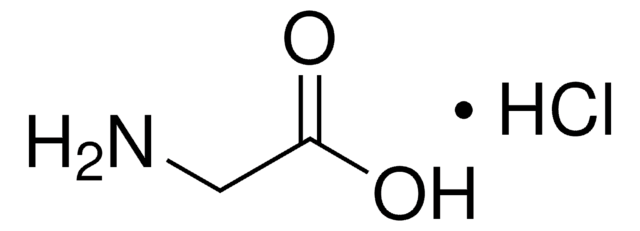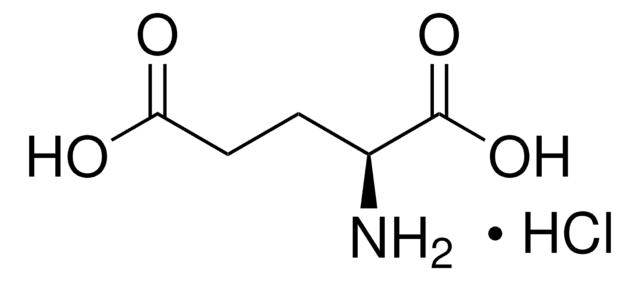G2879
Glycine hydrochloride
≥99% (HPLC)
Synonym(s):
Aminoacetic acid hydrochloride, Glycine HCl, Glycocoll hydrochloride, Aminoacetic acid, Aminoethanoic acid, Glycocoll
About This Item
Recommended Products
Quality Level
Assay
≥99% (HPLC)
form
powder
mol wt
111.53
storage condition
(Tightly closed Dry)
concentration
≤100%
technique(s)
immunohistochemistry: suitable
mp
176-180 °C (lit.)
solubility
water: 0.5 g/mL, clear, colorless
storage temp.
room temp
SMILES string
Cl.NCC(O)=O
InChI
1S/C2H5NO2.ClH/c3-1-2(4)5;/h1,3H2,(H,4,5);1H
InChI key
IVLXQGJVBGMLRR-UHFFFAOYSA-N
Looking for similar products? Visit Product Comparison Guide
General description
Application
- in the preparation of glycine-HCl buffer
- to elute serum immunoglobulins (IgGs) from the beads in order to check for the complete enrichment of core- and site-specific antibodies
- to regenerate the sensor to elute the bound C-reactive protein (CRP)
Biochem/physiol Actions
related product
Signal Word
Danger
Hazard Statements
Precautionary Statements
Hazard Classifications
Eye Dam. 1 - Skin Corr. 1
Storage Class Code
8A - Combustible corrosive hazardous materials
WGK
WGK 1
Flash Point(F)
Not applicable
Flash Point(C)
Not applicable
Personal Protective Equipment
Regulatory Listings
Regulatory Listings are mainly provided for chemical products. Only limited information can be provided here for non-chemical products. No entry means none of the components are listed. It is the user’s obligation to ensure the safe and legal use of the product.
JAN Code
G2879-1KG:
G2879-BULK-PC:
G2879-500G:
G2879-BULK:
G2879-VAR:
G2879-100G:
Certificates of Analysis (COA)
Search for Certificates of Analysis (COA) by entering the products Lot/Batch Number. Lot and Batch Numbers can be found on a product’s label following the words ‘Lot’ or ‘Batch’.
Already Own This Product?
Find documentation for the products that you have recently purchased in the Document Library.
Customers Also Viewed
Our team of scientists has experience in all areas of research including Life Science, Material Science, Chemical Synthesis, Chromatography, Analytical and many others.
Contact Technical Service






